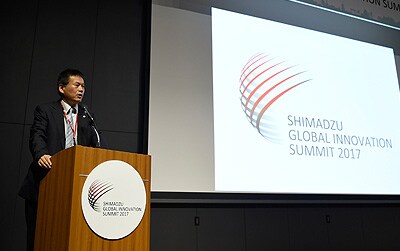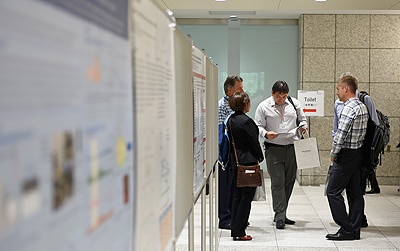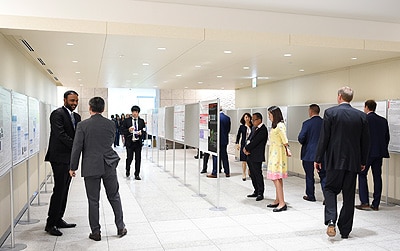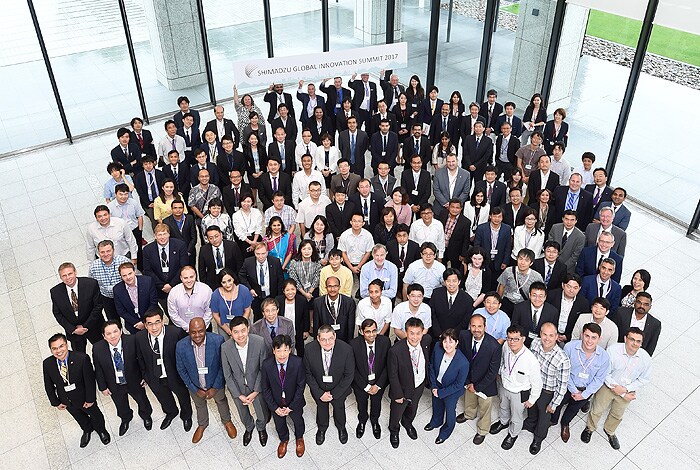Shimadzu Global Innovation Summit 2017
Event Report

Introduction
Shimadzu hosted its inaugural Shimadzu Global Innovation Summit as a platform for Key Opinion Leaders (KOL) and emerging thought leaders (ETL) to join Shimadzu executives and scientists to discuss the use of analytical technologies to study challenges of society such as human health, food safety and environmental conservation. The aim of the summit was both to bring attention to Shimadzu the needs for new analytical technology of its many users and to stimulate new research collaborations between the KOL, ETL, and Shimadzu. The event took place on July 4 and 5, 2017, at the Shimadzu Corporation Headquarters in Kyoto, Japan. More than 100 people representing 16 countries attended. The vast majority of participants represented national universities or research institutes. Talks were given by 11 KOL, and 49 posters by ETL were presented, of which 6 were chosen to give short talks on the second day. The summit also included a number of KOL-led panel discussions, a tour of the Shimadzu factory, a banquet dinner on July 4, and a tour of Kyoto organized on July 6.


Objectives

The Global Innovation Summit was designed to share and discuss the latest topics in a range of clinical, pharmaceutical, food, and environmental applications. Less to solve any one pressing problem, the summit was designed to bring together researchers of different fields to establish new collaborations with Shimadzu and other participating scientists.
- For Shimadzu to continuously fulfill its corporate philosophy of “contributing to society through science and technology”, it is essential to keep in regular contact with its more frequent users. The summit was designed for partnering researchers to engage directly with Shimadzu executives and scientists about their research goals and the analytical technologies necessary to accomplish these goals.
- While many researchers at leading institutes attend international conferences to share their latest data, they usually select conferences with common research themes. At the summit, disparate themes were covered, ranging from water contamination to disease diagnostics in order to introduce Shimadzu users to new ideas on how present Shimadzu technology can be used.
- ETL who are at the beginning of their careers rarely have the opportunity to interact with KOL. The summit was kept intentionally small in terms of participant number to facilitate this interaction and also to convey to Shimadzu technology needs for their research.
Organization of the summit
The two-day event was organized so that talks were completed before lunch and panel discussions and poster presentations occurred afterwards. Sessions were divided as follows:
July 4
Session 1: Collaborative research with Shimadzu and the breakthrough to innovation
Session 2: (Parallel sessions) Food&Environment and Clinical&Pharmaceutical
Session 3: Posters
(Evening): Gala Dinner
July 5
Session 1: Presentation by poster awarded emerging thought leaders
Session 2: Shimadzu analytical and medical products fueling R&D
Session 3: Open Round Table
Participants
The event welcomed over 100 participants from 16 nations including Australia, Austria, China, India, Indonesia, Italy, Japan, Malaysia, Philippines, Singapore, South Africa, Taiwan, Thailand, the United Kingdom, the United States, and Viet Nam. Besides Shimadzu, all but two organizations with attending representatives were universities or national research institutes. Thus, the vast majority of attendees held doctorates and were professors or laboratory scientists.
Speakers and Moderators
The 11 KOL invited to speak included the following (in order of appearance):
- Eiichiro Fukusaki, Professor, Osaka University, Japan
- Erich Leitner, Professor and Head of the Institute of Analytical Chemistry and Food Chemistry, Graz University of Technology, Austria
- Sanjeeva Srivastava, Associate Professor, Indian Institute of Technology, Mumbai, India
- Kevin A. Schug, Professor, The University of Texas at Arlington, TX, U.S.
- Michelle McIntosh, Associate Professor, Monash University, Australia
- Chunhua Zhang, Director, Matsumoto Institute of Life Science, Japan
- Hian Kee Lee, Professor, National University of Singapore, Singapore
- Yi Chen, Professor, Chinese Academy of Sciences, China
- Alex J. Rai, Associate Professor and Director, Special Chemistry Laboratories, Columbia University College of Physicians and Surgeons, New York, NY, U.S.
- Sen Takeda, Professor and Chairman, University of Yamanashi, Japan
- Hisataka Kobayashi, Chief Scientist of Molecular Imaging Program, National Cancer Institute/ National Institute of Health, MD, U.S.
The Moderators were as follows:
- John Hewetson, Director/General Manager, Shimadzu Australasia
- Prem Anand, Senior General Manager, Shimadzu Asia Pacific
- Cao Lei, General Manager of Marketing, Analytical & Measuring Instruments Division, Shimadzu China
- Uwe Opperman, Manager, Shimadzu Europa
- Scott Kuzdzal, Director of Marketing, Shimadzu Scientific Instruments
- Atsuro Ueyanagi, General Manager of Global Marketing, Analytical & Measuring Instruments Division, Shimadzu Corporation
In addition, 6 poster presenters were selected to give talks on the second day of the summit. Those speakers were (in order of appearance):
- Stefani Nicole Thomas, Clinical Chemistry Fellow, Johns Hopkins University, MD, U.S.
- Kei Zaitsu, Associate Professor, Nagoya University, Japan
- Nelson Rodrigo Vinueza Benitez, Assistant Professor, North Carolina State University, NC, U.S.
- Yoshihiro Izumi, Associate Professor, Kyushu University, Japan
- Inȇs Carvalho dos Santos, Post -doctoral Fellow, The University of Texas at Arlington, TX, U.S.
- Takahisa Murata, Associate Professor, The University of Tokyo, Japan



